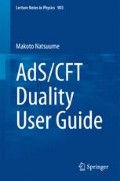Abstract
So far we discussed equilibrium physics. In order to apply AdS/CFT to nonequilibrium physics, we explain the basics of nonequilibrium physics. We explain it both from the microscopic point of view (linear response theory) and from the macroscopic point of view (hydrodynamics).
Access this chapter
Tax calculation will be finalised at checkout
Purchases are for personal use only
Notes
- 1.
Traditionally, pure ensemble and mixed ensemble are called as pure states and mixed states.
- 2.
Some explanation is probably necessary for the fluid. Of course, in real experiments, one does not curve our spacetime. We regard the spacetime fluctuation as an external source here because we would like to discuss the fluid on the same footing as the other systems such as the magnetic system. (We explain this in Sect. 9.3.2, but this is convenient to derive the so-called Kubo formula.) In any case, there is no problem to consider such a source and a response in principle since spacetime fluctuations bring up fluctuations in the energy-momentum tensor according to general relativity.
- 3.
In this book, we consider only at the linear level, but nonlinear cases are interesting both in statistical mechanics and in AdS/CFT.
- 4.
Various conventions are found in the literature about the sign of the perturbed Hamiltonian \(\delta H\) (the sign of the perturbed action \(\delta \mathsf {S}\)) and the sign of the retarded Green’s function \(G_R\). Accordingly, the linear response relation (9.31) or (9.32) may have a sign difference.
- 5.
The response function differs from the Green’s function by a minus sign traditionally since it is natural to define the response function as \(\chi = \delta \langle O\rangle _s/\delta \phi ^{(0)}\).
- 6.
This is the AC conductivity or the frequency-dependent conductivity. The DC conductivity is given by the \(\omega \rightarrow 0\) limit of Eq. (9.42):

- 7.
We consider a system of one particle species for simplicity.
- 8.
This does not hold for black holes with compact horizon. See Chap. 3 Appendix.
- 9.
This relation can be derived from statistical mechanics using the results of Sect. 7.2.2. Rewrite \(\varepsilon _\text {B}\) in terms of \(s_\text {B}\) (by taking into account that the photon has two degrees of freedom).
- 10.
Thermodynamics is traditionally applied to systems with various chemical components, so \(\mu \) is called the chemical potential. But the use of \(\mu \) is not limited to a chemical system. For example, \(\mu \) can be a gauge potential for a charged particle or can be a potential which is conjugate to non-chemical particle number (such as the baryon number). We use the same terminology, chemical potential, even for those cases. In any case, \(\mu \) represents the potential energy for a matter flow.
- 11.
In this sense, a thermodynamic potential should be called a fundamental relation in a particular representation.
- 12.
Landau-Lifshitz [2] is rather old, but it is still a good textbook on hydrodynamics.
- 13.
For example, in order to extract the conductivity, it is enough to know the \(O(\omega )\) part of the Green’s function \(G_R^{xx}\) in the \({\varvec{q}}\rightarrow 0\) limit. See Eq. (9.41).
- 14.
In order to obtain a closed expression from Eqs. (9.76) and (9.81), use the heat capacity \(C=\partial \varepsilon /\partial T\). Then, one gets \(\partial _0\varepsilon = (\kappa /C) \partial _i^2\varepsilon \). The heat diffusion constant \(D_T\) satisfies \(\kappa = D_T C\), which is the heat version of Eq. (9.87).
- 15.
The philosophy is somewhat similar to the derivation of the energy-momentum tensor in Sect. 5.3.2. Even if one is not really interested in field theory in the curved spacetime, the coupling with gravity is a convenient way to derive the energy-momentum tensor.
- 16.
The appearance of \((\varepsilon +P)\) in a relativistic fluid plays a vital role in various phenomena. The gravitational collapse of a star to a black hole comes from this effect. For a star to be stable, a pressure is necessary to overcome gravity. But for a massive enough star, once nuclear reactions are over, no pressure can hold the star. In general relativity, the whole \(T^{\mu \nu }\) is the source of the gravitational field, so a large pressure is self-destructive; it only increases the source. As a result, a black hole is born.
- 17.
The Eckart frame is also called as the Particle frame and the N-frame. The corresponding names for the Landau-Lifshitz frame are the Energy frame and the E-frame. (The E-frame does not stand for Eckart, which is rather confusing.)
- 18.
In this case, the simple physical consideration was enough to determine \(u^\mu \). In general, given an external perturbation, the conservation equation determines hydrodynamic variables \(u^\mu \) and \(\varepsilon \) in terms of the perturbation.
- 19.
To derive this result, consider the perturbation of the form

- 20.
In later chapters, we omit “ \({\bar{}}\) ” for simplicity, so we will write \(\eta /s\) instead of \(\eta /\bar{s}\).
References
H.B. Callen, Thermodynamics and an Introduction to Thermostatistics (Wiley, New York, 1985)
L.D. Landau, E.M. Lifshytz, Fluid Mechanics, 2nd edn. (Elsevier, New York, 1987)
Author information
Authors and Affiliations
Corresponding author
Rights and permissions
Copyright information
© 2015 Springer Japan
About this chapter
Cite this chapter
Natsuume, M. (2015). Basics of Nonequilibrium Physics. In: AdS/CFT Duality User Guide. Lecture Notes in Physics, vol 903. Springer, Tokyo. https://doi.org/10.1007/978-4-431-55441-7_9
Download citation
DOI: https://doi.org/10.1007/978-4-431-55441-7_9
Published:
Publisher Name: Springer, Tokyo
Print ISBN: 978-4-431-55440-0
Online ISBN: 978-4-431-55441-7
eBook Packages: Physics and AstronomyPhysics and Astronomy (R0)



